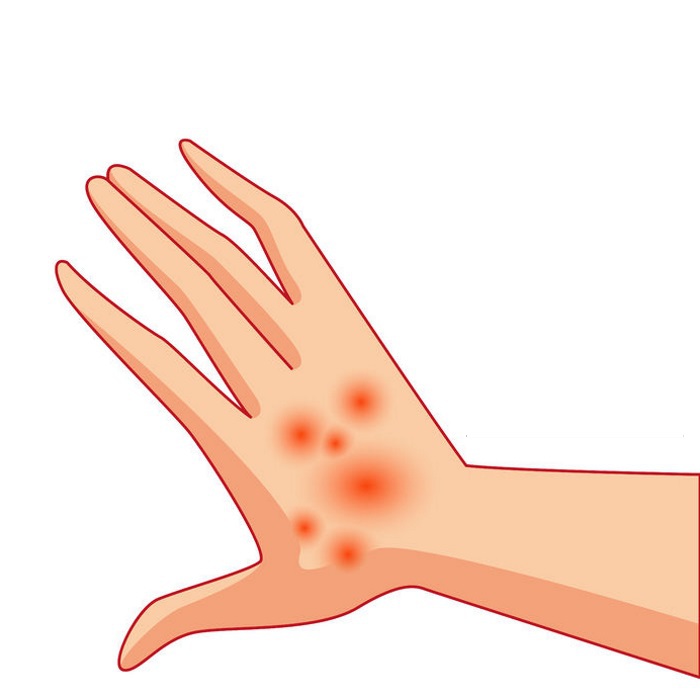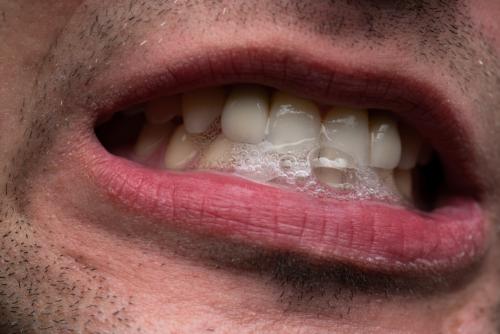Polymorphic Erythema - Causes, Symptoms, Treatment and Evolution

Polymorph is an acute recurrent disease caused by varied factors, including viral infections or medications. It is thought to be a sensitivity reaction as a consequence of interacting with these stimuli. The most common cases of polymorphic erythema are caused by infection with the herpes virus, especially with the mouth and mouth disease, and the most common cases of polymorphic erythema. . There are other infectious agents involved: mycoplasma pneumoniae, herpes zoster, hepatitis virus, cytomegalovirus, Ebstein-Barr, yersinia, HIV, mycotic skin infections. Medicines are also associated with polymorphic erythema, especially in the more severe, mucosal.
The list is open to anticonvulsants (carbamazepine, valproic acid), followed by antibiotics (penicillin, ampicillin, tepracycline, rifampicin) or vaccines. There are certain people (the cause being genetic influence, people with slow hepatic acetylation) who are prone to such a disease. Erythema arises 3-14 days after the infectious episode. Symptoms of polymorphic erythema Erythema multiform affects both skin and mucous membranes. Two forms are described: minor and major polymorphic erythema.
Small polymorphic erythema suddenly starts, most often without associated symptoms. Rarely, it can start with flu-like symptoms, followed by rash. The lesions begin at the extremities (hands, feet, ears) and extend over 72 hours; . They can spread all over the body, but are especially present in the palms, face, neck, some confluent, giving rise to larger lesions. The most common cause of minor erythema is herpes infection.
Major polymorphic erythema starts with flu-like manifestations (fever, cough, altered general condition) or digestive (vomiting, diarrhea). The lesions also start at the extremities, but they are rapidly expanding, with particular interest in the mucous membranes. All mucous membranes (buccal, conjunctival, genital) may be affected with severa, painful erosions, bleeding, lacrimation, photophobia, unable to feed. They are most often caused by medicines. top Diagnostic and laboratory analysis Diagnosis is based on the clinical examination.
Sometimes the biopsy followed by the histopathological examination can be useful when we ask the problem of another diagnosis. Severe, widespread skin and mucous membrane require general paraclinical assessment to evaluate systemic resonance. Laboratory analyzes can also be helpful in identifying the triggering infectious agent. top Treatment for polymorphic erythema In limited forms of lesions, treatment is not necessary; . In extended forms, active intervention is required to stimulate re-epithelization of the skin and mucous membranes, to combat associated infections and other complications.
If the infectious agent has been identified, specific treatment (antibiotic, antiviral). There is no clear treatment for this condition, most often we try to hurry and reduce the manifestations by local and systemic administration of corticosteroids or antihistamines. top Evolution, prognosis, complications The lesion evolution extends over 2-3 weeks; . Major polymorphic erythemas associate more severe manifestations due to impaired skin surface or mucosal involvement. There is a mortality below 5%.
Risks of complications with secondary infections. Old age, affecting other organs, other associated conditions can worsen prognosis. There is a risk of dehydration, hydroelectrolytic disorders caused by the massive loss of fluid through the affected skin, the inability to feed normally. Healing in the mucous membranes can be done with strictures, scars (eg corneal scars). The most common recurrences occur in the case of minor polymorphic erythema and are caused by herpes simplex infection; .
It has the role of limiting herpes infection. It is important to identify the episode of polymorphic erythema, to know that the one with restricted skin involvement with limited lesions has a mild evolution; . Causative agent identification may limit the recurrence of polymorphic erythroid episodes. .
Source : csid.ro
Views : 4482
Popular Article
- (photo) Nude becomes art.
Posted: 2018-03-17, 9748 views.
- The harmful effects of air conditioning on the skin
Posted: 2017-06-08, 8452 views.
- 3 causes of dyed hair discoloration
Posted: 2017-06-15, 8330 views.
- Why early puberty occurs in girls: symptoms, favors, diagnosis and treatment
Posted: 2017-10-24, 8175 views.
- Good or bad skin treatments in the hot season
Posted: 2017-06-07, 7906 views.
Recommendations
- (photo) Nude becomes art.
Posted: 2018-03-17, 9748 views.
- The harmful effects of air conditioning on the skin
Posted: 2017-06-08, 8452 views.
- 3 causes of dyed hair discoloration
Posted: 2017-06-15, 8330 views.
- Good or bad skin treatments in the hot season
Posted: 2017-06-07, 7906 views.
- Risks of practicing sports on hot days
Posted: 2017-06-12, 7493 views.
 4 effective ingredients in the fight against acne.
4 effective ingredients in the fight against acne. How to get rid of hiccups fast
How to get rid of hiccups fast The wheat bran diet: the secret of lost pounds as if by magic
The wheat bran diet: the secret of lost pounds as if by magic The recipe that will sweeten your soul this weekend!
The recipe that will sweeten your soul this weekend!  Is it dangerous or not to refreeze meat after thawing it?
Is it dangerous or not to refreeze meat after thawing it?  The unusual sign of diabetes indicated by saliva.
The unusual sign of diabetes indicated by saliva. What to drink to boost your immune system.
What to drink to boost your immune system. 10 foods that help you never age.
10 foods that help you never age. What actually happens in your body if you drink a cup of coffee for breakfast
What actually happens in your body if you drink a cup of coffee for breakfast 5 surprising benefits of chia seeds
5 surprising benefits of chia seeds